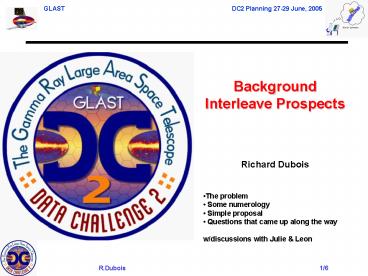Background Interleave Prospects - PowerPoint PPT Presentation
1 / 6
Title:
Background Interleave Prospects
Description:
Questions that came up along the way. w/discussions with Julie & Leon ... Intermix with signal events. GLAST DC2 Planning 27-29 June, 2005. R.Dubois 5 /6 ... – PowerPoint PPT presentation
Number of Views:11
Avg rating:3.0/5.0
Title: Background Interleave Prospects
1
- Background Interleave Prospects
- Richard Dubois
- The problem
- Some numerology
- Simple proposal
- Questions that came up along the way
- w/discussions with Julie Leon
2
The Problem
- We need to generate the full background rate to
see what gets through the Onboard Filter - 25 kHz of input from backgrounds source
- 300 Hz of background in the downlink
- Few Hz of signal
- Too much CPU time to run backgrounds for full
month - Weve said we would run one day and re-use them
for the rest of the month - Now to figure out how to do that!
- Analyses involving less than one day duration
will only see 1 copy of the backgrounds - Otherwise we will see events turn up multiple
times
3
Some Numerology
- Toby currently estimates 23 kHz input rate for
backgrounds - 86.4k secs/day
- From last weeks runs 13k triggered events take
1800 CPU secs 0.13 s/evt (this includes sim of
the events which do not trigger) - 1 day input background 86.4k x 23k 2B events
- 2B 0.13 / 86.4k 3k CPU-days 300 CPUs for 10
days - After Onboard Filter - 300 Hz 26M events/day
- 1 TB for full trees for the day
- AllGamma (0.018-180 GeV) runs show 2.8k events
taking 3.4k secs 1.2 s/evt upper limit on
signal? - 5 Hz signal 430k events
- 30 days ?115 CPU-days
4
Initial Proposal
- Ignoring details for the moment
- Create (logical) output tuple file interspersing
background events from the one day - Ignore deadtime effects (what can we do
otherwise? We tossed the input event times!) - Assume all background events are equivalent
- Only orbit dependence is rate
- Parametrize rate dependence in orbit
- Use 30 day pointing file to set rate and grab
events from parametrization select at random
from day 1. - Intermix with signal events
5
Reality Checks Questions
- Final ntuple would be O(1B) events!
- Do we provide everyone with all events?
- And/or provide standard cuts to greatly pare down
size - Standard background rejection cuts?
- Loose cuts (10 solution)?
- Natural to correspond to discrete set of IRFs
- How to
- Reorder renumber events so they appear to be in
order (else is great clue to analysts!) - Point back to original tree events (hmm. Would
have to hide this via the dataserver?) - Parametrize the rate
- Just run background source? What are key
variables? More than latitude and longitude? Does
rocking angle matter? - How to pick numbers of events vs time since rate
is time variable (my ignorance obviously this is
known since we do it in flux already!)?
6
More Wrinkles
- What if we didnt make an explicit final dataset?
- Hide everything behind the dataserver?
- It has one copy of signal and backgrounds and
does bookkeeping to return a dataset for any
query - By default would always return same events for a
given query (ie deterministic selection vs time) - Could imagine allowing it to optionally randomize
backgrounds as way to do multiple experiments?
Does this make sense or is the right thing for
people to just run ObsSim? - Of course, people could ask for the entire
dataset if they wanted 1B events ? 5 TB (hmmm) - Ask for reduced set of columns of tuple?
- akin to L1 definition
- 25 vars (floats) would lead to 100 GB file































